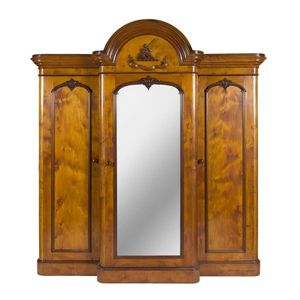Victorian Huon Pine Wardrobe with Mirror
You must be a subscriber, and be logged in to view price and dealer details.
Subscribe Now to view actual auction price for this item
When you subscribe, you have the option of setting the currency in which to display prices to $Au, $US, $NZ or Stg.
- Victorian Period - The Victorian period of furniture and decorative arts design covers the reign of Queen Victoria from 1837 to 1901. There was not one dominant style of furniture in the Victorian period. Designers used and modified many historical styles such as Gothic, Tudor, Elizabethan, English Rococo, Neoclassical and others, although use of some styles, such as English Rococo and Gothic tended to dominate the furniture manufacture of the period.
The Victorian period was preceded by the Regency and William IV periods, and followed by the Edwardian period, named for Edward VII (1841 ? 1910) who was King of the United Kingdom and the British Dominions and Emperor of India for the brief period from 1901 until his death in 1910. - Breakfront - A design generally found in larger pieces of furniture, such as bookcases, wardrobes and some sideboards. The line of the front is interrupted by the middle section standing out from each end. In a reverse breakfront, the centre section is recessed behind each end. Breakfronted pieces are usually made in three sections the middle and the two wings which are held together by the cornice and pediment, and the plinth on which it stands. The sensible buyer should show caution before buying breakfront pieces, especially bookcases, which are highly desirable and expensive. Always check that the timber, colour, patination, backboards, decoration and thickness of the wood are same in each section.
- Huon Pine - Named after the Frenchman who discovered the Huon River in Tasmania, it is an extremely slow growing and long living tree. Huon pine is native to Tasmania, and it can grow to an age of 3,000 years or more. The wood contains oil that retards the growth of fungi, hence its early popularity in ship-building in convict-era Tasmania. The timber is a warm yellow colour, finely grained, and was popular for household furniture in the Victorian era. Interestingly, much Huon pine furniture was made in South Australia. Huon pine is a protected species and only limited quantities are available nowadays, for craftsmen to manufacture small items such as platters, sculptures and other decorative objects.
This item has been included into following indexes:
- wardrobes, period or style
- wardrobes, timber - Huon pine 30
Visually similar items

A breakfront wardrobe, huon pine, circa 1875, fitted with secret drawer, 245 cm high, 227 cm wide, 65 cm deep

Cedar wardrobe, Victorian with three panelled doors, centred with a mirror, height 215 length 190 depth 55 cm

A magnificent three door wardrobe, solid huon pine with break front and carved blackwood armorial crest within a domed pediment, circa 1875, 246 cm high, 230 cm wide, 70 cm deep. Provenance: Originally the property of William M'Millan of Landcox, Union Str

A Victorian burr walnut breakfront wardrobe, the central door with a mirror, the interior with three drawers and four slides, the two side cupboards lined with William Morris style fabric, the arched pediment with carved detail to the centre, raised on pli
